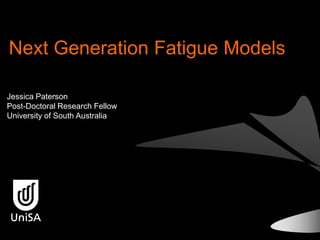2010 CRC Showcase - Safety & Security - Next Generation Fatigue Models R2.110
- 1. Next Generation Fatigue Models Jessica Paterson Post-Doctoral Research Fellow University of South Australia
- 2. Fatigue Risk Management Hazard assessment Error Trajectory Control Mechanism Adequate Prescriptive HOS rule sleep opportunity? Fatigue modelling Level 1 Adequate Personal PSWM Level 2 sleep obtained? Sleep diaries Are there fatigue- Level 3 Subjective reports Fatigue models measure the sleep opportunity related behaviours ? Symptom checklist associated with a roster, not fatigue. Have there been Level 4 Analysis of errors and
- 3. Fatigue Modelling Tools Shift Start and Finish Time Shift Timing Shift Duration Work History Circadian ŌĆśValueŌĆÖ of a Rest Period Fatigue score of between 80-100 currently used as cut-off. Comparable to BAC .05
- 4. Prescriptive Rules Permitted and Safe Not- Permitted and Not Safe
- 5. Prescriptive Rules Permitted and Permitted Not Safe and Safe Not- Not-Permitted Permitted and and Not Safe Safe
- 6. Prescriptive Rules Permitted Permitted and Unsafe Not Safe and Safe Not- Not-Permitted Permitted Inefficient and and Not Safe Safe
- 7. Fatigue Models Green Yellow Red Black
- 8. Fatigue Models Green Yellow Red Black Permitted and Safe Not- Permitted and Not Safe
- 9. Fatigue Models Green Yellow Red Black Permitted Permitted and Safe and Unsafe Not Safe Not-Permitted Not- Inefficient and Permitted Safe and Not Safe
- 10. Next Generation Fatigue Models Permitted and Safe Not- Permitted and Not Safe
- 11. Next Generation Fatigue Models Permitted Permitted and Safe and Unsafe Not Safe Not Inefficient Permitted Not- And Safe Permitted and Not Safe
- 12. To enhance the sleep/wake/work database that underpins fatigue modeling algorithms Demographic Information Sleep, Work and Fatigue diaries Activity Monitoring 300 Rail Employees Multiple Workgroups Drivers and Support Crew Tradespeople Management 4000-5000 days and nights of data
- 13. O O O O
- 14. O O O O
- 16. The Final Product A next generation fatigue modelling tool which is: - Representative of different social and domestic profiles of various workgroups - Provides a indicator of the proportion of employees that fall in the low, moderate or high fatigue category relative to their working time
- 17. The Final Product A more scientifically defensible approach to Fatigue Management in the Australian Rail Industry ŌĆ”a safer and more efficient railway.

















